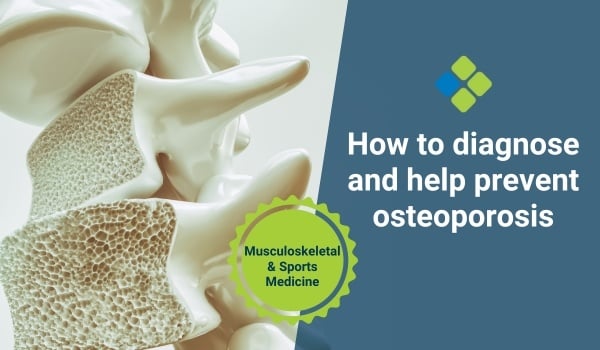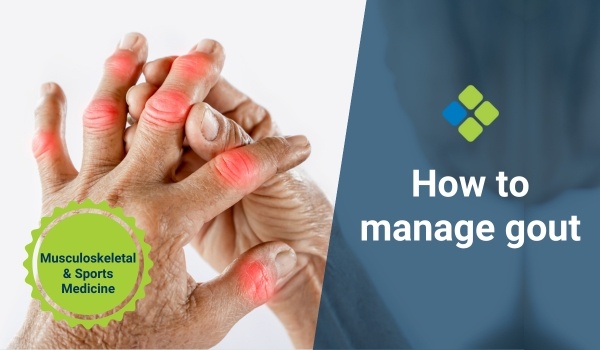How to diagnose and help prevent osteoporosis
Read how GPs can work with patients to address modifiable risk factors to help reduce the occurrence of early onset osteoporosis and prevent fractures.

HealthCert Education
Did you know that by 2025 around 2.6 million people are estimated to sustain hip fractures due to clinical manifestation of osteoporosis? Evidence shows that this number has doubled since 1990 and is estimated to increase by 4.5 million by 2050.
What is osteoporosis?
Osteoporosis is a “silent epidemic” widely affecting men and women over the age of 50. Osteoporosis is a progressive metabolic bone disease that weakens the microarchitecture of bone. It occurs when there is an imbalance between the bone minerals and components. This leads to increased bone fragility and low bone mass resulting in sudden fractures.
Risk factors for osteoporosis
Osteoporosis is a chronic systemic skeletal disease. It doesn’t show any symptoms until its clinical manifestations emerge as serious complications.
Osteoporosis is a non-communicable disease with can have a severe negative impact on quality of life. Therefore, it is essential to adequately manage the modifiable risk factors where possible.
Modifiable risk factors
- Nutrition: Deficiency of calcium and vitamin D
- Unbalanced diet: Excessive salt, phosphate and protein intake
- Drug use due to primary or secondary disease: Chemotherapy, sedatives, anti-convulsants
- Sedentary lifestyle: Excessive caffeine, alcohol, vaping, smoking, unhealthy body fat, and increased weight due to unhealthy diet.
- Endocrine factors: Late menarche, infertility, imbalanced changes in menstrual cycle, stress, obesity or anorexia nervosa, excessive exercise, bearing mechanical load without exercising.
Non-modifiable risk factors
- Genetic predisposition
- Gender: Females are affected by 2:1 more than men. However, by 2050, there is predicted to be a 310% increase in men
- Ethnicity: Caucasians, Asians, and Black women are at greater risk
- Age: The peak number of hip fractures occur at 75-79 years of age; for all other fractures, the peak number occur at 50-59 years and decrease with age
Diagnosing osteoporosis
DXA/DEXA scans
Bone density scans / dual-energy x-ray absorptiometry (DEXA) is a fast, non-invasive method used to identify osteoporosis. It is regarded as the standard method of detecting low bone mineral density and diagnosing osteoporosis in early stages.
A DEXA scan is recommended in patients who:
- Are over the age of 50
- Are post-menopausal women
- Have a history of sudden fracture (hip and vertebral fractures are most common)
- Have systemic illness such as rheumatoid arthritis, irritable bowel syndrome, chronic renal or liver disease, metabolic disease, respiratory disease drug abuse, or cancer
- Are type 1 diabetic
- Have hyperthyroidism or use thyroid replacement drugs
DEXA scan interpretation
The T-score depicts a patient's bone mass compared to the peak bone mass in a healthy young person of the same gender. It depicts the incidence of fracture and treatment requirements.
- 1- score is normal
- -1.1 and -2.4 score suggests osteopenia
- -2.5 and below score indicates osteoporosis
Using the Z-score, the patient’s body mass index is compared to a healthy adult of the same gender, age, ethnicity, height, and weight who has peak bone mass. The calculation of Z-score is similar to T-score.
The Fracture Risk Assessment Tool (FRAX score), developed by WHO, is used to determine the risk of having a major fracture (e.g. hip fracture) and other sudden fractures in the next 10 years due to osteoporosis.
Treatment options
The long term goal of healthcare providers is to prevent bone loss, increase bone density, and minimise the incidence of fractures. The doctor should first treat the root cause of the bone loss (e.g. if the patient has osteoporosis due to secondary disease complications such as chronic renal disease, chronic lung disease, or rheumatoid arthritis).
Nutrition
Adequate nutrition is essential to meet the daily recommended dose of calcium and vitamin D. Leafy green vegetables, dairy products, Greek yoghurt, and fish are rich sources of essential nutrients for the body.
For 19- to 50-year-olds, the recommended daily dose of calcium is 1000 mg/day and of vitamin D is 600 iu/day.
Exercise
According to Wolf’s law the bones become denser and stronger with weight bearing activities. This means that exercise has a positive impact on bone health.
Medications
If the patient's nutrient intake is not fulfilled by organic nutrition then the doctor can recommend calcium and vitamin D supplements (Bisphosphonate).
Hormone therapy (SERM/ PTHrP analog / RANKL inhibitor) is also recommended for post-menopausal women.
Osteoporosis is a non-communicable disease caused by chronic health conditions, insufficient nutrition, or a sedentary lifestyle. By working with the patient to address modifiable risk factors, GPs can help reduce the occurrence of early onset osteoporosis and help prevent major fractures.
- Dr Humda, Physiotherapist
Learn more about this topic in the HealthCert Professional Diploma program in Musculoskeletal & Sports Medicine - fully online or with optional practical workshops.
Engaging with this blog can help meet your annual
|
|
If you consume educational webinars, podcasts, articles, or research on this blog, you can Quick Log CPD hours with the RACGP via the usual self-submission process. You will be asked to reflect on what you have learned, and you will require supporting evidence such as a screenshot. |

 1800 867 1390
1800 867 1390







